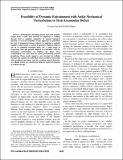Feasibility of dynamic entrainment with ankle mechanical perturbation to treat locomotor deficit
Author(s)
Ahn, Jooeun; Hogan, Neville
DownloadAhn-2010-Feasibility of dynam.pdf (762.7Kb)
PUBLISHER_POLICY
Publisher Policy
Article is made available in accordance with the publisher's policy and may be subject to US copyright law. Please refer to the publisher's site for terms of use.
Terms of use
Metadata
Show full item recordAbstract
Dynamically entraining human gait with periodic torque from a robot may provide an approach to walking therapy that is uniquely supportive of normal biological function. To test the feasibility of this approach we perturbed the gait of unimpaired human subjects by applying a periodic impulsive ankle torque at various frequencies. Eighteen subjects out of 19 exhibited entrained gaits: for a small range of frequencies their gait periods adapted to synchronize with the mechanical perturbation. In addition, the phase when synchronized was such that the robot perturbation assisted propulsion. These results support a new strategy for walking therapy that exploits an embedded neural oscillator interacting with peripheral mechanics and the resulting natural dynamics of walking, which are essential but hitherto neglected elements of walking therapy.
Date issued
2010-08Department
Massachusetts Institute of Technology. Department of Brain and Cognitive Sciences; Massachusetts Institute of Technology. Department of Mechanical EngineeringJournal
Proceedings of the 32nd Annual International Conference of the IEEE, Engineering in Medicine and Biology Society (EMBC 2010)
Publisher
Institute of Electrical and Electronics Engineers
Citation
Ahn, Jooeun and Neville Hogan. “Feasibility of Dynamic Entrainment with Ankle Mechanical Perturbation to Treat Locomotor Deficit.” Proceedings of the 32nd Annual International Conference of the IEEE Engineering in Medicine and Biology. Buenos Aires, Argentina, August 31-September 4, 2010. 3422-3425.© IEEE.
Version: Final published version
Other identifiers
INSPEC Accession Number: 11650398
ISBN
978-1-4244-4123-5
ISSN
1557-170X